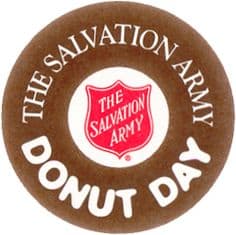
Soon after the US entrance into World War I in 1917, The Salvation Army sent a fact-finding mission to France. The mission concluded that the needs of US enlisted men could be met by canteens/social centers termed “huts” that could serve baked goods, provide writing supplies and stamps, and provide a clothes-mending service. Typically, six staff members per hut would include four female volunteers who could “mother” the boys. These huts were established by The Salvation Army in the United States near army training centers.
About 250 Salvation Army volunteers went to France. Because of the difficulties of providing freshly baked goods from huts established in abandoned buildings near the front lines, Salvation Army volunteers, Ensign Margaret Sheldon and Adjutant Helen Purviance came up with the idea of providing doughnuts. Margaret Sheldon wrote of one busy day: “Today I made 22 pies, 300 doughnuts, 700 cups of coffee.” Soon, the women who did this work became known by the servicemen as “Doughnut Dollies”. (Wikipedia)
The first dough was rolled into shape by hand, but soon employed an ordinary wine bottle as a rolling pin. Since they had no doughnut cutter, the lassies used a knife to cut the dough into strips and then twisted them into crullers.
Ensign Purviance coaxed the wood fire in the potbellied stove to keep it at an even heat for frying. Because it was back-breaking to lean over the low fire, she spent most of the time kneeling in front of the stove. “I was literally on my knees,” she recalled, “when those first doughnuts were fried, seven at a time, in a small frypan. There was also a prayer in my heart that somehow this home touch would do more for those who ate the doughnuts than satisfy a physical hunger”.
Soon the tempting aroma of frying doughnuts drew a lengthy line of soldiers to the hut. Standing in mud and rain, they patiently waited their turn.

Although the girls worked late into the night, they could serve only 150 doughnuts the first day. The next day, that number was doubled. A while later, when fully equipped for the job, they fried from 2,500 to 9,000 doughnuts daily, as did other lassies along the frontline trenches.
After several soldiers asked, “Can’t you make a doughnut with a hole in it?”, Ensign Purviance had an elderly French blacksmith improvise a doughnut cutter by fastening the top of a condensed milk can and camphor-ice tube to a wooden block. Later, all sorts of other inventions were employed, such as the lid from a baking powder can or a lamp chimney to cut the doughnut, with the top of a coffee percolator to make the hole.
The soldiers cheered the doughnuts and soon referred to Salvation Army lassies as “Doughnut Girls”. (WorldWarI.com)
In 1938, the Chicago branch of The Salvation Army began National Doughnut Day as a fund raiser to help the needy during the Great Depression and to honor the “Doughnut Girls” of World War I. Today, this unofficial holiday falls on the first Friday of June.


References & Links:
The Salvation Army https://centralusa.salvationarmy.org/metro/donutdayhistory/ & Wikipedia, WWI.com)
Wikipedia https://en.wikipedia.org/wiki/National_Doughnut_Day#cite_note-Holey_holiday-1
WorldWar1.com http://www.worldwar1.com/dbc/doughnut.htm
